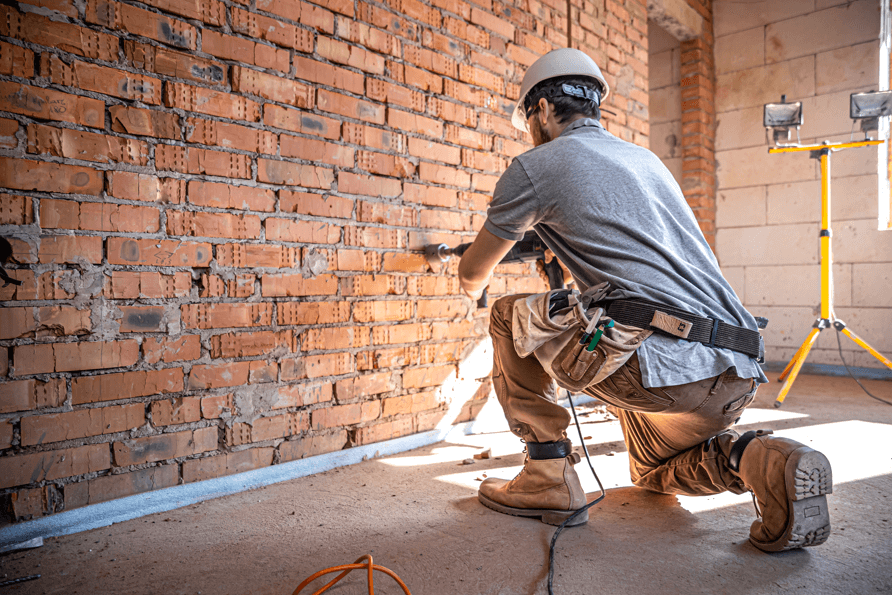What Does Remedial Work Mean in Building and Construction?
Remedial work in the building and construction industry refers to the process of identifying and correcting defects or deterioration in a structure to restore its integrity, safety, and functionality. Over time, buildings in York can develop a range of issues—from structural failures to plumbing or electrical faults, water ingress, or inadequate insulation.
The primary goal of remedial building work in York is to prevent further damage, improve safety, and extend the lifespan of the structure. This can include reinforcing weakened structural elements, upgrading outdated systems, and implementing effective waterproofing and damp-proofing measures.
Remedial work is the targeted intervention required to address and resolve these problems, on this page we’ll explore the meaning of remedial work, the types of defects that commonly require intervention, and why timely remediation is essential for maintaining any building.
Schedule a call with our
Remedial Building Maintenance Team
Common Types of Building Defects in York
Homeowners and property managers should be aware of several frequent building defects, including:
- Structural Cracking: Often caused by foundation movement or settlement, resulting in visible cracks in walls or floors.
- Water Leakage: Can lead to mold growth, timber rot, and structural deterioration.
- Inadequate Insulation: Reduces energy efficiency and leads to higher utility bills.
- Poor Workmanship: Examples include uneven flooring, faulty wiring, or misaligned plumbing fixtures.
Each of these issues can lead to more serious problems if not addressed promptly through remedial work.

Why Remedial Work is Important for Building Maintenance in York
TimYork remedial work in York is critical in preserving a building’s structural soundness and aesthetic value. By addressing emerging defects early, property owners can avoid more extensive and costly repairs down the line.
Regular inspections and maintenance help detect potential problems before they escalate, ensuring buildings remain safe, efficient, and visually appealing.
Common Types of Remedial Building Work
Structural Repairs and Reinforcements
Structural issues often arise from aging, natural events, or construction flaws. Remedial structural work includes:
- Repairing cracks in walls, ceilings, or foundations.
- Replacing damaged beams or columns.
- Reinforcing load-bearing elements to restore stability.
This work ensures buildings remain safe and capable of handling their intended loads.
Waterproofing and Damp Proofing in York
Waterproofing protects against water penetration, while damp proofing blocks moisture transfer—especially from rising damp. Solutions include:
- Liquid membranes and bituminous coatings.
- Waterproof barriers and drainage systems.
- Sealants applied to vulnerable areas.
Effective moisture control helps prevent long-term structural and health-related issues.
Façade Restoration and Repair
Façade restoration focuses on maintaining the exterior appearance and weather resistance of a building. This may involve:
- Repairing cracks or damaged surfaces.
- Repointing, cleaning, or replacing worn-out materials.
- Applying protective coatings to withstand environmental exposure.
A well-maintained façade enhances both value and visual appeal.
Foundation Stabilisation
Foundations in York may weaken over time due to soil movement or construction defects. Stabilisation methods include:
- Underpinning to strengthen foundations.
- Slabjacking to level sunken concrete slabs.
- Installing helical piers for additional support.
These techniques ensure long-term stability and prevent further structural damage.
Cavity Flashing
Cavity flashing prevents water ingress between the inner and outer walls. If flashing is missing or deteriorated, water can seep in, causing:
- Mold growth.
- Timber rot.
- Structural degradation.
Remedial work involves repairing or replacing flashing to maintain a dry and healthy interior.
Concrete Rot Repair
Also known as concrete spalling, this occurs when internal steel reinforcements corrode, expand, and cause concrete to crack. The process for repair includes:
- Assessing the damage through inspections.
- Removing damaged concrete and treating corroded steel.
- Reapplying repair mortar and waterproofing coatings.
Addressing concrete rot early prolongs the structure’s lifespan and reduces future repair needs.
Frequently Asked Questions
How much does remedial work typically cost?
Costs vary significantly based on the scope and type of work. The extent of damage, materials required, and complexity of the repairs all influence the final price.
What are common signs of structural damage?
Look for wall or foundation cracks, sagging floors, misaligned doors/windows, or signs of excessive moisture or mold.
Can waterproofing be applied to existing buildings?
Yes. Waterproofing and damp proofing can be retrofitted to existing buildings, making them more resistant to water damage even after construction is complete.
